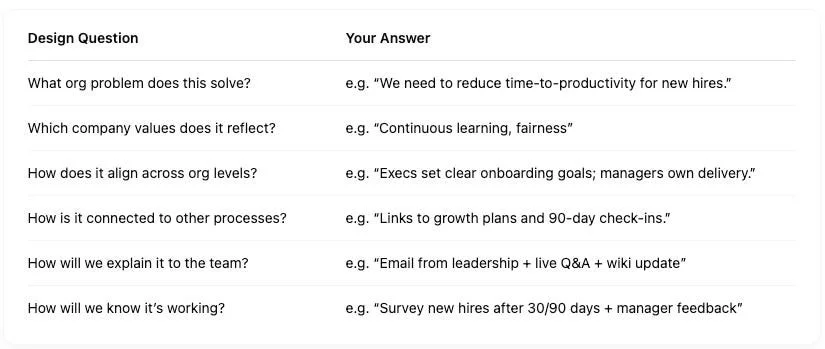How We Used Values as a Trojan Horse for a Scalable People Strategy
It all begins with an idea.
A few years ago, I joined a Romanian tech company with 40 employees, three HR processes, and exactly zero structure.
But hey, at least there was payroll.
When I asked how roles were defined, someone pointed at a whiteboard where the founders had split leadership duties like they were divvying up house chores.
One said, “I handle performance reviews… when I remember.”
And yet, the culture was strong. People were decent to each other. They delivered. They cared.
But care and chaos can only take you so far.
The founders had big plans—doubling headcount in under two years—and they brought me in to help. The mandate: “build people systems that scale without killing what makes us us.”
So we turned to a concept that’s usually reserved for manufacturing: vertical integration.
Spoiler: it works for people, too.
What the Hell is Vertical Integration (in HR)?
In the business world, vertical integration means owning your whole supply chain—from raw materials to customer delivery. Think IKEA, but for couches and meatballs.
In HR, vertical integration means designing people processes that:
Align across all layers of the organization—strategy, middle management, and day-to-day ops.
Work across every stage of the employee lifecycle—from hiring to offboarding—with a common logic and purpose.
The point is to build coherence. Not just a bunch of isolated “HR things” floating in the void.
At most companies, this doesn’t happen. Strategy lives in slides. Hiring is based on vibes. Managers do their own thing. Training is a wishlist.
And somehow, everyone is shocked when growth gets painful.
Scaling Without Duct Tape
When I joined the company, here’s what we had:
✔️ Payroll
✔️ Recruiting
❌ Anything else remotely resembling people strategy
Also:
❌ Defined structure
❌ Clear roles
❌ Leadership consistency
✔️ Strong values (but only verbalized, never written)
So we started with a deceptively simple question: What do we want to keep sacred while we grow?
The answer: fairness, continuous learning, excellent delivery.
These weren’t marketing fluff—they were already embedded in how people worked. So we used them as our North Star.
Every new process had to meet three criteria:
Is it fair and transparent?
Does it integrate with what we already have?
Does it solve a real organizational challenge?
No HR-as-performative-theater allowed.
Building the System
I used those values to guide a full vertical build-out of our people systems:
At the strategic level: I worked with founders to translate company goals into role clarity, structure, and people priorities.
At the tactical level: I partnered with middle managers to build feedback loops, solve coordination issues, and pilot team-level improvements.
At the operational level: We gave employees visibility into growth paths, learning opportunities, and internal projects based on their interests.
We also set up an internal marketplace for skill-building—because in our world, skills > titles. Promotions weren’t just “because it’s time.” They were earned by growing, not coasting.
Processes got automated where they could—hiring, onboarding, performance feedback, comp & ben, even offboarding. But automation only worked because we designed the system to be values-led and user-friendly first.
And we communicated the hell out of it.
Over and over. Tailored by role, tenure, and even socioeconomic background.
(Yes, people in different life stages hear “career development” very differently.)
A Final Word on Feedback Loops
None of this works if it’s a one-and-done setup.
We built quarterly, anonymous pulse surveys to assess whether:
Processes feel fair
People understand the why
Managers are actually using the tools we gave them
If something’s broken, we fix it. If something’s unclear, we over-communicate. Again.
So, Does Vertical Integration Work?
Short answer: Yes—but only if you have a few things going for you:
A relatively clean slate
Leadership alignment
A central theme (aka values) to unify everything
In bigger companies, full org-wide vertical integration can feel like rolling a boulder uphill with a wet noodle.
But it is possible within departments or business units—if you have a clear enough vision and a solid translation layer between levels.
And most importantly, they help you scale without turning your culture into a ghost story.
✅ Vertical Integration Starter Checklist (for People Strategy)
Use this when you’re building or rebooting your people systems to scale:
🔁 Align Across Org Levels
Company strategy translated into people priorities
Role clarity at every level (not just titles)
Managers equipped to connect team goals to strategy
🧩 Connect the Employee Lifecycle
Hiring, onboarding, and offboarding follow a consistent logic
Performance feedback ties back to growth and values
Learning & development is embedded, not bolted on
🌱 Values-Led Design
Core values are clearly defined and behaviorally expressed
Every process links back to a value
Fairness, transparency, and purpose built into each process
📣 Over-Communicate (Seriously)
Tailor messaging by role and experience level
Repeat the why, not just the what
Use multiple channels (not just Slack dumps)
📊 Build Feedback Loops
Regular pulse surveys or feedback rituals
Leaders visibly act on feedback
Processes evolve based on real data
🧰 Mini Template: Designing a New People Process
Whenever you roll out something new (e.g. performance review, onboarding flow), run it through this:
If you found this helpful, subscribe for more thoughts on scaling people systems without losing your soul (or your sanity).


